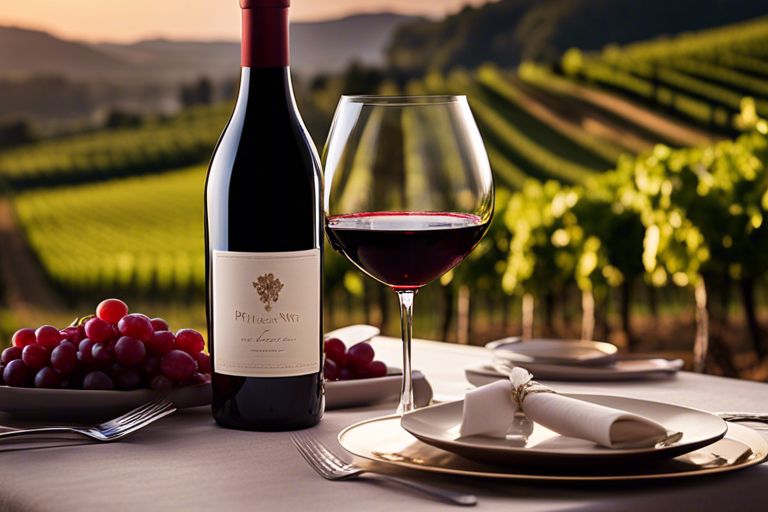
Are you ready to elevate your wine tasting experience with Alicante Henri Bouschet Red Wine? In this guide, we will take you through 10 important steps to fully appreciate and enjoy this rich and flavourful wine variety. From selecting the right glassware to serving at the perfect temperature, we will provide you with expert tips on how to indulge in the exquisite taste and aroma of Alicante Henri Bouschet Red Wine. Whether you are a wine enthusiast or a beginner looking to explore new flavours, these steps will enhance your enjoyment and help you savour every sip of this exceptional red wine blend.
Choose Quality Wine
Research vineyards
Before selecting a bottle of Alicante Henri Bouschet Red Wine, it is necessary to research the vineyards where the grapes are grown. Understanding the terroir, climate, and cultivation practices of a vineyard can give you valuable insights into the quality of the wine produced.
Read reviews
Reading reviews from wine experts and fellow wine enthusiasts can provide you with valuable guidance when choosing a bottle of Alicante Henri Bouschet Red Wine. Look for reviews that describe the flavour profile, aroma, and overall quality of the wine to ensure you are making a well-informed decision.
Reviews can also give you an idea of the best food pairings for the wine, allowing you to enhance your dining experience. Additionally, reading reviews can help you discover hidden gems and lesser-known producers that offer exceptional quality wines.
Proper Storage
Cool, dark place
It is important to store your Alicante Henri Bouschet Red Wine in a cool, dark place to maintain its quality and taste. Exposure to heat and light can cause the wine to age prematurely and develop off-flavours. A consistent temperature of around 10-15 degrees Celsius is ideal for storing red wines, so avoid fluctuations in temperature.
Horizontal positioning
Storing your Alicante Henri Bouschet Red Wine horizontally is crucial to keep the cork moist and prevent it from drying out. When a cork dries out, it can shrink and allow air to seep into the bottle, causing oxidation and ruining the wine. By storing the wine horizontally, the liquid inside the bottle keeps the cork moist, ensuring a proper seal and maintaining the wine’s integrity.
Right Temperature
| Cool before serving | Use thermometer |
It is crucial to cool Alicante Henri Bouschet red wine before serving to enhance its flavour profile. You can achieve this by placing the bottle in the refrigerator for about 30 minutes before opening. This will ensure that you enjoy the wine at the perfect temperature. | Using a thermometer is a precise way to ensure that your Alicante Henri Bouschet red wine is at the ideal temperature. The recommended serving temperature for this wine is between 16-18°C. By using a thermometer, you can accurately monitor the wine’s temperature and adjust accordingly to experience its full potential. |
When using a thermometer, remember that serving red wine too warm can lead to the alcohol dominating the taste and the aromas being muted. On the other hand, serving it too cold can mask its nuanced flavours and aromas. By maintaining the recommended serving temperature, you can fully appreciate the complexity of Alicante Henri Bouschet red wine.
Decanting Process
Open in advance
Before enjoying your Alicante Henri Bouschet Red Wine, it is crucial to open the bottle in advance to allow the wine to breathe. This process enhances the wine’s flavours and aromas, ensuring a more pleasurable drinking experience. Ideally, open the bottle at least one hour before serving to fully unlock the wine’s potential.
Pour carefully
When pouring your decanted Alicante Henri Bouschet Red Wine, handle the bottle carefully to avoid disturbing any sediment that may have settled. Hold the decanter steadily, and pour the wine slowly and steadily to prevent mixing the sediment back into the wine. This step is vital to ensure clarity and purity in each glass, enhancing the overall tasting experience.
Appropriate Glassware
Use large glasses
When enjoying Alicante Henri Bouschet Red Wine, it is necessary to use large glasses. A large bowl allows the wine to breathe, enhancing its aroma and flavour. The wide opening also allows you to fully appreciate the wine’s complex characteristics.
Clean thoroughly
Before serving your Alicante Henri Bouschet Red Wine, make sure to clean your glasses thoroughly. Any residue or soap remaining in the glass can affect the wine’s taste and bouquet. Rinse the glasses with warm water and let them air dry to ensure a pristine drinking experience.
Properly cleaned glasses ensure that you fully enjoy the rich colours and nuances of your wine without any interference. It may seem like a small detail, but it can make a significant difference in your overall wine-tasting experience.
Pouring Technique
Half-full glass
When pouring Alicante Henri Bouschet Red Wine, it is crucial to aim for a half-full glass. This will allow enough room for the wine to be swirled gently, releasing its aromas and enhancing the tasting experience.
Tilt gently
Another important aspect of pouring Alicante Henri Bouschet Red Wine is to tilt the glass gently while pouring. This helps to avoid any splashing or excessive aeration, which could alter the wine’s flavour profile and overall enjoyment.
Tilting the glass also ensures a smoother pour, helping to control the flow of the wine into the glass and preventing any spills. This small but significant detail can make a big difference in how the wine is presented and enjoyed.
Observing Color
Swirl gently
Before observing the colour of your Alicante Henri Bouschet red wine, gently swirl the glass to release its aromas. This action helps oxygenate the wine which can enhance the colour perception.
Note hues
Take note of the hues present in the wine. Alicante Henri Bouschet reds typically exhibit deep, dark hues ranging from crimson to ruby red. These colours can give an indication of the grape varietals used and the age of the wine.
When observing the hues of your Alicante Henri Bouschet red wine, pay attention to any variations in colour intensity towards the rim of the glass. This can provide insights into the wine’s maturity and the winemaking techniques employed. Additionally, noting any hints of purple or brick-red can hint at the wine’s age and potential flavour profile.
Savoring Aroma
Deep inhales
Before taking your first sip of Alicante Henri Bouschet Red Wine, it is important to start by savouring its aroma. Take a moment to bring the glass to your nose and deeply inhale, allowing the rich scents to envelop your senses. This will help prepare your palate for the flavours to come.
Identify notes
When identifying the notes in Alicante Henri Bouschet Red Wine, pay attention to the various aromas that may be present. Notes of dark fruits such as blackberries and plums, hints of spices like pepper and cinnamon, and even earthy undertones can all contribute to the complex bouquet of this wine. By training your nose to pick up on these nuances, you can fully appreciate the depth of its aroma.
Tasting
Small sips
When tasting Alicante Henri Bouschet Red Wine, it is crucial to take small sips to fully appreciate the complex flavours and aromas. By taking small sips, you allow the wine to coat your palate and reveal its nuances gradually. This method also helps in identifying different layers of taste, from the initial burst of fruit to the lingering finish.
Let linger
After taking a small sip of Alicante Henri Bouschet Red Wine, let it linger in your mouth for a few moments. This allows the wine to interact with your taste buds and fully express its character. Notice how the flavours develop and evolve as the wine sits on your palate. Pay attention to the texture, acidity, and tannins as they all play a vital role in the overall tasting experience.
Food Pairing
Complementary flavors
When pairing Alicante Henri Bouschet Red Wine with food, look for complementary flavours that enhance the wine’s rich and bold characteristics. Opt for dishes like lamb stew, beef bourguignon, or dark chocolate desserts to bring out the wine’s fruity and spicy notes.
Avoid clashes
Avoid pairing Alicante Henri Bouschet Red Wine with delicate or subtly flavoured dishes as they may clash with the wine’s robust profile. Steer clear of seafood dishes, light salads, or dishes with citrusy sauces to ensure a harmonious dining experience.
Clashes in food pairing can result in overpowering the wine or the dish, leading to an unbalanced flavour profile. It is important to consider the intensity of the wine and the dish to create a harmonious pairing that allows both to shine without one overpowering the other.
Sip Mindfully
No distractions
When sipping Alicante Henri Bouschet Red Wine, it’s important to eliminate distractions so you can truly appreciate the flavours and aromas. Find a quiet space where you can focus on each sip, allowing the wine to take centre stage without any interruptions.
Enjoy nuances
To fully enjoy the Alicante Henri Bouschet Red Wine, take the time to savour the nuances of its complex profile. Notice the hints of blackberry, plum, and spice that intermingle with the smooth tannins and lingering finish. Each sip reveals a new layer of depth and character, making the experience all the more rewarding.
By paying attention to these subtle nuances, you can truly appreciate the craftsmanship and artistry that went into creating this exceptional wine. Let each sip linger on your palate, allowing the flavours to dance and evolve, leaving you with a lasting impression of this unique varietal.
Sharing Experience
Invite friends
One of the best ways to enjoy Alicante Henri Bouschet Red Wine is by inviting friends to share the experience with you. Hosting a wine tasting gathering can be a fun and educational way to explore the unique characteristics of this exquisite wine. Encourage your friends to bring their own favourite wine as well, to make the event more diverse and enjoyable.
Discuss impressions
After enjoying a glass or two of Alicante Henri Bouschet Red Wine with your friends, take some time to discuss your impressions of the wine. Talk about the aroma, taste, body, and overall experience of the wine. Share your thoughts and listen to what others have to say. This can help you develop a deeper appreciation for the wine and also enhance your wine tasting skills.
Discussing impressions can also lead to interesting conversations about food pairings, serving temperatures, and the best occasions to enjoy Alicante Henri Bouschet Red Wine. It’s a great way to learn from each other and discover new ways to fully savour this delightful wine.
Explore Varietals
Try different years
When exploring Alicante Henri Bouschet red wine, it is important to try bottles from different years to truly appreciate the nuances of this unique varietal. Each vintage can bring out different characteristics in the wine, allowing you to discover your preferred style and flavour profile.
Note preferences
Take the time to note down your preferences when tasting Alicante Henri Bouschet red wine. Whether you enjoy bold and robust flavours or prefer a smoother and more delicate taste, keeping track of your preferences will help you when selecting bottles in the future. Pay attention to the aromas, tannins, acidity, and overall balance of the wine to pinpoint your personal favourites.
10 Steps To Enjoying Alicante Henri Bouschet Red Wine
In a nutshell, enjoying Alicante Henri Bouschet red wine is a delightful experience that can be enhanced by following these 10 steps. From selecting the perfect bottle to pairing it with the right food, each step plays a crucial role in ensuring a memorable tasting experience. By taking the time to appreciate the unique characteristics of this vibrant red wine, you can truly savour its rich flavours and aromas. So, next time you pour yourself a glass of Alicante Henri Bouschet, make sure to follow these steps to make the most of your tasting journey.

